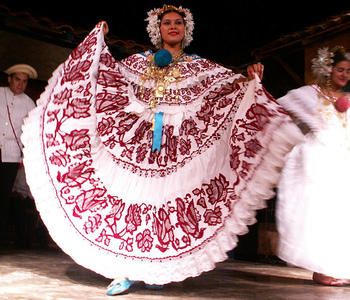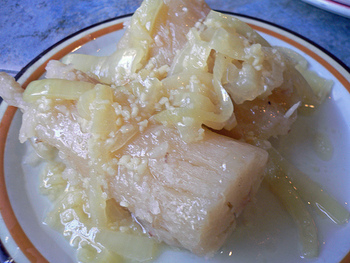Christmas in Central America
From the 16th of December until Christmas Eve people in Mexico perform "las posadas" (in Spanish "the inns"). Each posada is actually kind of play about Mary and Joseph searching for a place where Jesus would be born. Places where posadas are held change from home to home in certain neighbourhood. Each home has a role of innkeepers. People from the neighbourhood are the pilgrims or "peregrinos" which look for a place to stay. They go from house to house and sing traditional songs about pilgrims. All of them carry lit candles. Four pilgrims carry small statues of Joseph leading a donkey with Mary riding it. Sometimes there are real persons dressed as Joseph and Mary. A real donkey ("burrito") can be used too.
A person heading this processions holds a candle placed inside a paper shade. This little lantern is called "farolito". People in each home they visit do not allow them to stay. Two sides communicate through singing. Finally the pilgrims arrive to the place where the posada is organized. When the "innkeepers" let pilgrims in everyone kneels in front of the nativity scene and pray rosary. Sometimes a place where the posada is organized can be a church.
After the prayer there is a small party for kids. It usually includes a piñata. It is filled with fruit or sweets. There is something for the adults too. They drink "Ponche con Piquete" or "Punch". It is made of different fruits, cinnamon and alcoholic beverage. During Christmas season Mexicans also have "Pastorales" which are plays about shepherds on their way to honour Baby Jesus.
Most of places in Mexico have beautiful Christmas markets with stalls or "puestos" filled with different fruits, sweets or flowers. At midnight on Christmas Eve people attend a mass. After the mass there is a family dinner. A figure of Baby Jesus is then placed to the nativity scene.
 Rosca de Reyes
Rosca de Reyes
Children in Mexico get presents on Epiphany or "El día de Reyes", which is on the 6th of January. Few days before this day children go to the main square in town or "zócalo." They arrive there with little pieces of paper with their wishes written on them. Each paper is tied to a colourful balloon and released up in the air. Important part of this day is a light meal called "La Merienda." It consists of hot chocolate ("chocolate caliente") and "Rosca de Reyes." The Rosca de Reyes is a wreath-shaped bread with dry fruit and sugar sprinkled on it. Inside this bread there is little doll representing Baby Jesus.
On the 2nd of February there is a holiday called "Día de la Candelaria" or "Candlemas." The person who got the doll organizes a party. He or she also makes a "Ropon" or christening gown for Baby Jesus. On this day people usually eat lot of tamales. A tamale is a steam-cooked corn dough ("masa") with or without a filling. Different fillings like meat, cheese or chillies can be used. Before cooking a tamale is wrapped in corn husks or plantain leaves.
In the afternoon of the 7th of December churches and cathedrals in Nicaragua are full of people. A yell can be heard at the beginning of celebration - "Quién causa tanta alegría? (Who causes so much happiness?). Everyone responses - "La Concepción de María" (Mary’s Conception). This tradition is called "La Gritería". At exactly 6.00 pm many people arrive on streets and "shout". This means that they visited all the altars and sang songs dedicated to Virgin Mary.
 La Purísima home altar
La Purísima home altar
"La Purísima" or Immaculate Conception of the Blessed Virgin Mary is a very important part of Christmas season in Nicaragua. The actual festivity is on the 8th December. But celebrations last for a month or even more. A statue of Virgin Mary is placed in beautifully decorated home altar. In front of this altar people put chairs for all those attending the ceremony. Everyone prays and sings. Lot of sweets and drinks are served. One family member standing outside the house fires numerous rockets and firecrackers ("caraga cerrada").
People in Nicaragua also have something what they call a Christmas hug. Family members, cousins and friends hug each other as sign of reconciliation. In Nicaraguan city of Bluefields people traditionally celebrate Christmas by making a soup and inviting everyone to join them.
On Christmas Eve people of Honduras go to church. Around midnight they have a special dinner. The dinner traditionally includes tamales, roasted pork or chicken with rice. Torrejas are usually eaten as the dessert. Torrejas are pieces of bread with an egg glaze. They are fried and boiled with honey and cinnamon. Traditional Honduran Christmas drink is called rompopo. It is prepared with milk, egg yolks, sugar, cinnamon, cloves and liquor.
The most important Christmas tree in Costa Rica is the one in front of the Children’s Hospital in capital city San Jose. Christmas in Costa Rica is also a time for the Festival de la Luz or Festival of Light when the whole city shines beautifully.
 Festival de la Luz in San Jose, Costa Rica
Festival de la Luz in San Jose, Costa Rica
Local Christmas meal usually includes chicken and pork tamales. People drink lot of eggnog and rum punch. On the 26h of December there is an important horseback parade called the "Tope". The day after this parade there is another one called "Carnaval". Everybody is having a good time.
 La pollara dress of Panama
La pollara dress of Panama
Numerous parades are also part of Christmas season in Panama. Christmas parade in Panama City is the most important one. In the centre of attention are poor children who are invited to join the parade. Traditional dresses called "polleras" are worn by local women. Men also wear traditional clothes called "monunos".
When preparing for Christmas people in Jamaica clean their houses, hang new curtains and decorations. The Jamaicans drink red wine and eat a rum fruitcake. Both cake and fruit are kept soaked in white rum and red wine for several months before Christmas.
 Yuca con mojo
Yuca con mojo
The main Christmas food attraction in Cuba is a roasted pig. Along with it people usually eat black beans, rice and "yuca con mojo". Mojo is a special marinade made with garlic, onions and sour orange. Like everywhere else many different cakes and other sweet stuff are consumed. Cubans love fried dough "buñuelos", a nougat candy "turrones" etc. Lot of wine, beer and "sidra" (cider) is being drink.
 Junkanoo parade in the Bahamas
Junkanoo parade in the Bahamas
"Junkanoo" is the name of famous carnival parade held in the Bahamas three times a year. It is held on the Boxing Day, 26th of December and on the New Year's Day. There is a parade organized in the summer too. The biggest Junakanoo parade is the one held in country's capital Nassau. The story about origin of Junkanoo is quite interesting. The word junkanoo actually comes from "John Canoe". John Canoe was the 17th century slave master and trader. His slaves had very little freedom. They spent those rare moments of free time hidden in bushes. There they covered themselves with paint they made and different leaves they managed to find. They made music and danced a lot.
 Cassava pone
Cassava pone
Traditional Christmas dish in Barbados is called "Jug Jug". It is made with green peas, guinea corn (durra or Indian millet) flour, beef or other salted meat, onion and different herbs. Locals also enjoy roast turkey, pork, yam pie, candied sweet potatoes, Christmas cake, cassava pone etc. Cassava pone is a cake made of cassava (yuca or manioc) flour, coconuts and raisins.
People of Saint Lucia have a Christmas tradition called "bursting (busting) the bamboo”. From the end of November sound of bursting bamboo can be heard. Local men hollow out bamboos and with little kerosene, rags and sticks as fuses make cannons.
Also in Saint Lucia there is the Festival of Lights and Renewal. This festival honouring Saint Lucia is held on the 13th of December. It includes lantern-making competition. Christmas lights all over the country are turned on.
In St. Vincent and the Grenadines an interesting tradition is observed. It is called Nine Mornings. It is organized on the streets of Kingstown between the 16th and 24th of December. It includes numerous activities like street parades, singing of Christmas songs, bicycle races etc.
Christmas in Trinidad and Tobago just would not be the same without Parang. Parang is a form of traditional music. During Christmas season Parang musicians ("parranderos") go from house to house singing Christmas songs ("aguinaldo" or "serenal") and different secular songs like for example "guarapo". Parang music is performed with many musical instruments. Let's just name few of them - "cuatro" (small guitar), "maracas" or "chac chac" (rumba shakers), violin, guitar, claves or "toc toc", mandoline, tambourine etc. In each house they visit Parang musicians get a small reward for their music. Usually they get some food and drink (rum, eggnog called "ponche crema").